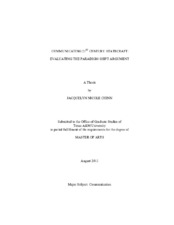| dc.description.abstract | This project examines how social media is being used by individuals within the State Department engaged in public diplomacy and how the use of these technologies may or may not represent a paradigm shift in diplomatic operation. Assessments of social media and government in popular culture argue a fundamental shift has taken place in government operations. Yet this argument calls for theoretical examination using communication theory and via examination of organizational praxis. Using Ammon's criterion for paradigm shift in communications technology and diplomacy, I evaluated State's current program of social media and public diplomacy called 21st Century Statecraft. I conducted a content analysis of organizational Twitter feeds and also interviewed actors within the organization working with public diplomacy and social media. I also examined historical accounts of State's Voice of America radio program, and compared current organizational uses of social media with the appropriation of radio in the second half of the 20th century.
The results suggest that paradigm shift has not yet occurred despite the uses of the new technologies. In many cases, social media is being used akin to technologies from previous paradigms due in part to the constraints of organizational structures. Twitter platforms were used as spaces to push information and policy to the masses, similar to the ways in which radio was used after World War II and throughout the Cold War. Organizational actors characterized social media as a tool to accomplish public diplomacy, not as the change agent those outside of the organization have argued it to be. They described organizational challenges of incorporating social media including questions of voice, information control, and doing 'in-reach' inside the organization. Finally, they described aspects of the interaction that took place as an opportunity to create dialogue amongst interested citizens around the world and to come into face-to-face contact with individuals outside the embassy. Although anomalous practices have begun to emerge as a result of new media's use in the State Department, we have not reached what Kuhn would term a 'critical mass,' necessitating a shift in worldview and practice. | en |


